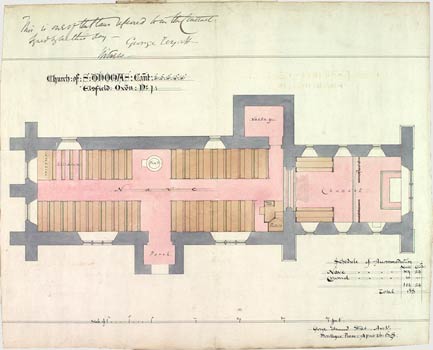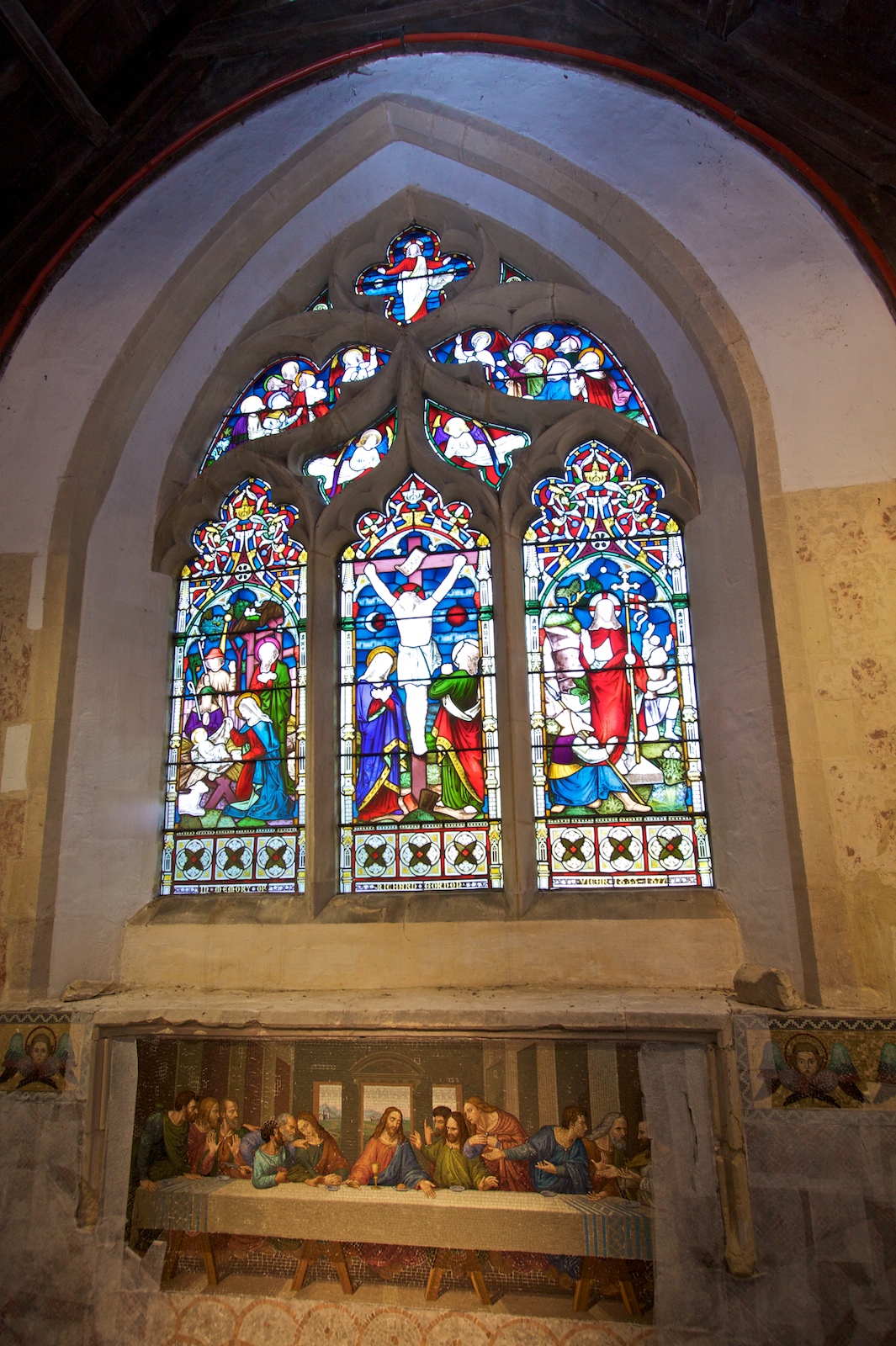Background
The parish church of St Thomas of Canterbury has stood in this small rural village just outside Oxford since at least 1122. In 1849 and 1859, when the Revd Richard Gordon was vicar, the building was restored in the English Gothic style and new seating was installed under the supervision of G. E. Street (see plan below).
It is thought that the mosaics were installed behind the altar in the 1860s or 1870s. The central panel on the east wall depicts the Last Supper after Leonardo da Vinci’s painting of the same subject in Milan. The mosaics are by Antonio Salviati (1816-1890), the founder of a glass making and mosaic company based at Murano near Venice, who installed mosaics in a large number of churches and cathedrals in Great Britain.

In 1994, a decision was taken by the village of Elsfield to alter the church to allow it to become a focus for the whole community. In the years immediately preceding this decision, the building had been little used and damp was causing the fabric to deteriorate. It was felt that greater use of the building would justify the cost of repairs and the installation of (badly needed) heating. The plans also included the creation of a community space and the building of an aisle-like extension to provide a kitchen, toilet and storage facilities.
A programme of fundraising began which brought the whole community together and, with the support of various grant giving bodies, a total of £225,00 was raised. The re-ordering was completed in 2003 when the Village Room was opened. In addition, repairs and improvements have been carried out to the external envelope of the building, particularly the east wall. The restoration of the mosaics, the crowning glory of the building, could not take place until the fabric of the building had been given time to dry out. Satisfactory environmental conditions have now been achieved so that the project to conserve the mosaics can be put in hand.
The church is listed Grade II* and stands in a conservation area within the green belt.
Antonio Salviati (1816-1890)
A native of Vicenza, Salviati trained as a lawyer, but became interested in glasswork after becoming involved in restoration to the mosaics of St Mark’s Cathedral in Venice. He opened his first glass business in 1859 in Murano with Lorenzo Radi (1803-1874) an expert glass technician, who had invented an economical method of producing metallic mosaic tiles and also achieving colours not previously available.
Murano had been a centre of fine glasswork since the Middle Ages, but the pieces were lavish and expensive. Salviati changed the face of the business by becoming the first glass factory owner to employ a large number of skilled workers to pre-fabricate mosaics intended for export. This re-established Murano as a centre of glass manufacturing.
In 1862, Salviati participated in the London International Exhibition and shortly afterwards opened a shop in Oxford Street to promote his products. With the support of Sir Austen Henry Layard, a wealthy British archaeologist, diplomat and MP, Salviati was awarded a number of prestigious commissions in Great Britain starting with the ceiling and walls of the portico of the Royal Mausoleum at Frogmore. Subsequently he was commissioned to provide mosaics for the Wolsey Chapel at Windsor and the Albert Memorial. His work was also installed in St Paul’s and Westminster Abbey, the latter a representation of the Last Supper designed by John Richard Clayton, which differs from the Elsfield design as Christ is shown standing and two apostles are seated in front of the table. A similar design of Last Supper to that at Elsfield was installed at St Bridget’s, Wavertree though in the latter case it fits into a curved apse rather than being installed on a flat wall.
In 1866 Venice joined the fledgling Kingdom of Italy. Salviati saw an opportunity to expand his business and attracted a number of British investors including Layard to support a significant expansion of capacity in Murano. The business seems to have been very successful. In 1867 Salviati wrote: “Already in more than fifty Catholic and Protestant Churches in England, there are Venetian mosaics that I have installed on the altars, the walls, the choirs, the pavements, the baptismal fonts etc.”
He also installed mosaics in other countries such as Egypt, Italy, Germany, France and the USA. Of particular historical interest is the mosaic portrait of President Abraham Lincoln (see below), which is now in the Senate in Washington DC. Although he split from his British backers in 1877, he set up on his own and following his death in 1890 his children continued to be active in mosaic manufacture. In particular, in 1900 the firm was commissioned to install the extensive mosaics at the Stanford Memorial Church in Palo Alto, California. The mosaics at Elsfield have thus been described as ‘a significant example of an international body of work’.

Restoration
The state of the mosaics at Elsfield in the early 2000s
The mosaics were constructed in six sections, with the figurative design of the Last Supper forming the altar reredos. Below the reredos, a central panel with fish-scale decoration is flanked by panels of diaper work to north and south. Decorative borders of gold mosaic and winged cherubs’ heads are set out above the diaper panels and set to each side of a 14th century limestone hood moulding, positioned across and to the side of the reredos.

A 1997 report on the mosaics by Cliveden Conservation identified iron fastenings behind the mosaics and the limestone moulding. A recent survey by Michael Eastham, a specialist conservator of sculpture based at Steventon, Oxfordshire, indicates the presence of a considerable amount of ferrous metal in the form of frames to each section and the fixings holding the back of the mosaics to the wall. The north side diaper panel is bulging dramatically (75 mm forward of the line of the wall) and other disruption to the mosaics may be the result of a combination of metal corrosion and expansion, compression force upon the tesserae from a distorting metal frame, failure of the wall fixings, or a combination of these factors.
The mosaics are currently supported in a number of places by specialist adhesive sheets (Eltoline tissue and 20% Paraloid B72 in acetone, an acrylic resin with good surface strength) applied in 1997 by Cliveden Conservation to prevent collapse in the event of further movement.
Proposed restoration
Michael Eastham proposed that the mosaic panelling should be taken off the wall and transported to his workshop. All existing metal fastenings will be removed and the east wall made good. At the workshop, the mosaics will be cleaned and re-backed with epoxy resin and then fixed to Hexlite board, a composite of aluminium honeycomb encased within skins of glass-fibre and epoxy resin. These lightweight boards, which are rigid, strong, flat and ready made, are used extensively in the aircraft industry, because of their extreme rigidity and strength. These qualities make them an ideal support for heavy items such as mosaics.
The mosaics will be taken back to the church and re-fitted to the east wall with stainless steel fixing points anchored in resin attached to similar points in the wall. A lead strip across the bottom of the mosaics will provide protection against rising damp. The rear of the panels will be protected by the Hexlite and by the inclusion of an air gap. The limestone hooding will also be repaired with new moulding where necessary.
It was estimated that the project would take at least four months to complete at a cost of about £50,000 plus VAT.
Bibliography
- Oxfordshire; Jennifer Sherwood and Nikolaus Pevsner (Yale University Press 2002)
- Venetian Glass Mosaics 1860 – 1917; Sheldon Barr (Antique Collectors Club 2008)
- On Mosaics; Dr Antonio Salviati (Wertheimer 1865)
Acknowledgement
Revd Ralph Williamson of Christ Church for the photographs of the mosaics

